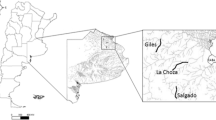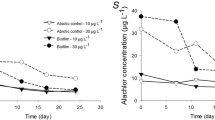Abstract
High-energy flowing water habitats such as waterfalls are uncommon in Antarctica, though they may become more regular as temperature increase. Both high spatial and temporal environmental variability is expected on them. The extent of their biological colonization will depend on the amount of ecological strategies displayed by the surrounding biota. We report here a study on phototrophic microbenthic communities inhabiting such environment in a stream on the Byers Peninsula of Livingston Island. Five different biofilms were distinguished by colour, and were located in specific microhabitat types in the waterfall, which flowed down a steep canyon. Photosynthetic pigment content and microscopic observations demonstrated a different assemblage of chlorophytes, cyanobacteria and diatoms among them. Biofilms were not randomly distributed in the stream channel, which may be related to water flow, nutrient availability and moisture. The exopolymeric substances content, stoichiometry and pigment composition varied among biofilms, likely reflecting differences in the water and nutrients availability. The photosynthetic rates were in the range of the observed in previous studies in the site and varied according to the habitat within the stream. Communities dominated by chlorophytes were restricted to the central channel, suggesting adaptation to faster flow regime. However, cyanobacterial biofilms appeared in a great range of environmental conditions. They were rare in the central channel where water flow was greatest, but achieved large biomass stocks on submerged and even exposed sites in the splash zone at the edge of the flowing water. This study shows how Antarctic biofilms can have a large variability in community structure and biomass over short length scales, reflecting the range of microhabitats in this Antarctic waterfall ecosystem, and the potential occurrence of different strategies to overcome fluctuating conditions.






Similar content being viewed by others
References
Anagnostidis K, Komarek J (1988) Modern approach to the classification system of cyanophytes. 3-Oscillatoriales. Arch Hydrobiol Suppl Algol Stud 50–53:327–472
APHA-AWWA-WPCF (1992) Standard methods for the examination of water and wastewater, 18th edn. American Public Health Association, Washington, DC
Ariosa Y, Carrasco D, Quesada A, Fernández-Valiente E (2006) Incorporation of different N sources and light response curves of nitrogenase and photosynthesis by cyanobacterial blooms from rice fields. Microb Ecol 51:394–403
Bradford MM (1976) A rapid and sensitive method for the quantification of microgram quantities of protein utilizing the principle of protein dye binding. Anal Biochem 72:248–259
Broady PA (1982) Taxonomy and ecology of algae in a freshwater stream in Taylor Valley, Victoria Land, Antarctica. Arch Hydrobiol Suppl Algol Stud 32:331–349
Camacho A, de Witt R (2003) Effect of nitrogen and phosphorus additions on a benthic microbial mat from a hypersaline lake. Aquat Microb Ecol 32:261–273
Caramujo MJ, Mendes CRB, Cartaxana P, Brotas V, Boavida MJ (2008) Influence of drought on algal biofilms and meiofaunal assemblages of temperate reservoirs and rivers. Hydrobiologia 598:77–94
Chiovitti A, Higgins MJ, Harper RE, Wetherbee R (2003) The complex polysaccharides of the raphid diatom Pinnularia viridis (Bacillariophyceae). J Phycol 39:543–554
Davey MC (1993) Carbon and nitrogen dynamics in a maritime Antarctic stream. Freshwater Biol 30:319–330
De Brouwer JFC, Stal LJ (2002) Daily fluctuations of exopolymers in cultures of the benthic diatoms Cylindrotheca closterium and Nitzschia sp. (Bacillariophyceae). J Phycol 38:464–472
Denys L (1990) Fragilaria blooms in the Holocene of the western coastal plains of Belgia. In: Simola H (ed) Proceedings of the tenth international diatom symposium, Joensuu, Finland, 28th August-2nd September 1988. Koeltz Scientific Books, Koenigstein, pp 397–406
Elster J (2002) Ecological classification of terrestrial algal communities in polar environments. In: Beyer L, Bölter M (eds) Geoecology of Antarctic ice-free coastal landscapes. Springer, Berlin, pp 303–326
Elster J, Komarek O (2003) Ecology of periphyton in a meltwater stream ecosystem in the maritime Antarctic. Antarct Sci 15:189–201
Fernández-Valiente E, Camacho A, Rochera C, Rico E, Vincent WF, Quesada A (2007) Community structure and physiological characterization of microbial mats in Byers Peninsula, Livingston Island (South Shetland Islands, Antarctica). FEMS Microbiol Ecol 59:377–385
Freeman C, Gresswell R, Guasch H, Hudson J, Lock MA, Reynolds B, Sabater F, Sabater S (1994) The role of drought in the impact of climatic change on the microbiota of peatland streams. Freshwater Biol 32:223–230
Guasch H, Martí E, Sabater S (1995) Nutrient enrichment effects on biofilm metabolism in a Mediterranean stream. Freshwater Biol 33:373–383
Hawes I (1989) Filamentous green algae in freshwater streams on Signy Island, Antarctica. Hydrobiologia 172:1–18
Herbert D, Phipps PJ, Strange RE (1971) Chemical analysis of microbial cells. In: Norris JR, Ribbons DW (eds) Methods in microbiology, vol 5B. Academic Press, London, pp 209–344
Inbar M (1995) Fluvial morphology and streamflow on Deception Island, Antarctica. Papers from symposium: Arctic and Alpine geomorphology and environmental change, Geografiska Annaler, series A. Phys Geogr 77:221–230
Komarek J, Anagnostidis K (1989) Modern approach to the classification system of cyanophytes. 4-Nostocales. Arch Hydrobiol Suppl Algol Stud 56:247–345
Kopalová K, Elster J, Nedbalová L, Van de Vijver B (2009) Three new terrestrial diatom species from seepage areas on James Ross Island (Antarctic Peninsula Region). Diatom Res 24:113–122
Kroen WK, Rayburn WR (1984) Influence of growth status and nutrients on extracellular polysaccharide synthesis by the soil alga Chlamydomonas mexicana (Chlorophyceae). J Phycol 20:253–257
Lotter AF, Bigler C (2000) Do diatoms in the Swiss Alps reflect the length of ice-cover? Aquat Sci 62:125–141
Margalef R (1960) Valeur indicatrice de la composition des pigments du phytoplankton sur la productivité, composition taxinomique et propiétés dynamiques des populations. Rapp Proc Verbo CIESM 15:277–281
Morris CE, Monier JM (2003) The ecological significance of biofilm formation by plant-associated bacteria. Annu Rev Phytopathol 41:429–453
Otero A, Vincenzini M (2004) Nostoc (Cyanophyceae) goes nude: extracellular polysaccharides serve as a sink for reducing power under unbalanced C/N metabolism. J Phycol 40:74–81
Pajdak-Stós A, Fialkowska E, Fyda J (2001) Phormidium autumnale (Cyanobacteria) defense against three ciliate grazer species. Aquat Microb Ecol 23:237–244
Paulsen BS, Vieira AAH (1994) Structure of the capsular and extracellular polysaccharides produced by the desmid Spondylosium panduriforme (Chlorophyta). J Phycol 30:638–641
Quayle WC, Peck LS, Peat H, Ellis-Evans JC, Harrigan PR (2002) Extreme responses to climate change in Antarctic lakes. Science 295:645
Rochera C, Justel A, Fernández-Valiente E, Bañón M, Rico E, Toro M, Camacho A, Quesada A (2010) Interannual meteorological variability and its effects on a lake from maritime Antarctica. Polar Biol 33:1615–1628
Rochera C, Villaescusa JA, Velázquez D, Fernández-Valiente E, Quesada A, Camacho A (2013) Vertical structure of bi-layered microbial mats from Byers Peninsula, Maritime Antarctica. Antarct Sci 25:270–276
Sabbe K, Verleyen E, Hodgson DA, Vanhoutte K, Vyverman W (2003) Benthic diatom flora of freshwater and saline lakes in the Larsemann Hills and Rauer Islands, East-Antarctica. Antarct Sci 15:227–248
Simon KS, Townsend CR, Biggs BJF, Bowden WB (2004) Temporal variation of N and P uptake in 2 New Zealand streams. JN Am Benthol Soc 24:1–18
Taton A, Grubisic S, Brambilla E, de Wit R, Wilmotte A (2003) Cyanobacterial diversity in natural and artificial microbial mats of Lake Fryxell (McMurdo Dry Valleys, Antarctica): a morphological and molecular approach. Appl Environ Microbiol 69:5157–5169
Toro M, Camacho A, Rochera C, Rico E, Bañón M, Fernández-Valiente E, Marco E, Justel A, Vincent WF, Avendaño MC, Ariosa Y, Quesada A (2007) Limnological characteristics of freshwater ecosystems of Byers Peninsula, Livingston Island (South Shetland Islands, Antarctica). Polar Biol 30:635–649
Van de Vijver B (2008) Pinnularia obaesa sp. nov. and P. australorabenhorstii sp. nov., two new large Pinnularia (sect. Distantes) from the Antarctic King George Island (South Shetland Islands). Diatom Res 22:221–232
Van de Vijver B, Beyens L (1999) Freshwater diatoms from Ile de la Possession (Crozet Archipelago, Subantarctica): an ecological assessment. Polar Biol 22:178–188
Van de Vijver B, Mataloni G (2008) New and interesting species in the genus Luticola D.G. Mann (Bacillariophyta) from Deception Island (South Shetland Islands). Phycologia 47:451–467
Van de Vijver B, Mataloni G, Stanish L, Spaulding S (2010a) New and interesting species of the genus Muelleria (Bacillariophyta) from the Antarctic Region and South Africa. Phycologia 49:22–41
Van de Vijver B, Sterken M, Vyverman W, Mataloni G, Nedbalova L, Kopalova K, Elster J, Verleyen E, Sabbe K (2010b) Four new non-marine diatom taxa from the Subantarctic and Antarctic Regions. Diatom Res 25:431–443
Van de Vijver B, Zidarova R, Sterken M, Verleyen E, de Haan M, Vyverman W, Hinz F, Sabbe K (2011) Revision of the genus Navicula s.s. (Bacillariophyceae) in inland waters of the Sub-Antarctic and Antarctic with the description of five new species. Phycologia 50:281–297
van Dongen BE, Schouten S, Sinninghe Damsté JS (2002) Carbon isotopic variability in algal and terrestrial carbohydrates. Mar Ecol Prog Ser 232:83–92
Vaughan DG, Marshall G, Connolley WM, Parkinson C, Mulvaney R, Hodgson DA, King JC, Pudsey CJ, Turner J, Wolff E (2003) Recent rapid regional climate warming on the Antarctic Peninsula. Clim Change 60:243–274
Velázquez D, Rochera C, Camacho A, Quesada A (2011) Temperature effects on carbon and nitrogen metabolism in some maritime Antarctic freshwater phototrophic communities. Polar Biol 34:1045–1055
Vincent WF, Howard-Williams C (1986) Antarctic stream ecosystem: physiological ecology of a blue-green algal epilithon. Freshw Biol 16:219–233
Vincent WF, Howard-Williams C, Broady PA (1993) Microbial communities and processes in Antarctic flowing waters. In: Friedman EI (ed) Antarctic microbiology. Wiley, New York, pp 543–569
Acknowledgments
Fieldwork was supported by grant REN2000-0435-ANT from the Science and Technology Ministry (Spain) to AQ. Sample processing was supported by grant CGL2005-06549-C02-02/ANT from the Spanish Ministry of Education and Science to AC, which was co-financed by European FEDER funds. We are very thankful to the UTM (Maritime Technology Unit, CSIC) and Las Palmas crew (Spanish Navy) who provided us with the logistical support to make possible this expedition. We also acknowledge the constructive comments of the reviewers.
Author information
Authors and Affiliations
Corresponding author
Rights and permissions
About this article
Cite this article
Rochera, C., Fernández-Valiente, E., Van de Vijver, B. et al. Community structure and photosynthetic activity of benthic biofilms from a waterfall in the maritime Antarctica. Polar Biol 36, 1709–1722 (2013). https://doi.org/10.1007/s00300-013-1388-3
Received:
Revised:
Accepted:
Published:
Issue Date:
DOI: https://doi.org/10.1007/s00300-013-1388-3




